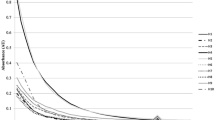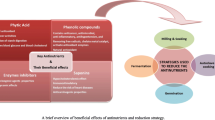Abstract
Five wild edible mushroom species, Amanita rubescens var. rubescens, Boletus edulis, Geopora arenicola, Morchella deliciosa and Sparassis crispa collected from different regions of Jammu and Kashmir were biochemically characterized for their nutritive value and a significant variation was observed among them. The total protein, phenol, crude fibre and ash content of these mushrooms were estimated on the dry weight basis which ranged from 16.2 ± 0.72 to 31.3 ± 1.15 mg/g, 5100 ± 100.0 to 11,500 ± 866.0 mg/kg, 3.9 ± 0.05 to 6.5 ± 0.50 %, 4.9 ± 0.11 to 9.9 ± 0.11 %, respectively. Also, these investigated macrofungal species were found to contain some important minerals like Zn, Cu, Mn and Fe. Of these, iron was the most dominant mineral followed by zinc, copper and manganese. This study suggests that these investigated wild edible mushrooms are rich in nutrients, minerals and due to the presence of phenols these may be used as source of natural antioxidants.

Similar content being viewed by others
References
Manzi P, Aguzzi A, Pizzoferrato L (2001) Nutritional value of mushrooms widely consumed in Italy. Food Chem 73:321–325
Chang ST, Miles PG (2004) Mushrooms: cultivation, nutritional value, medicinal effect and environmental impact, 2nd edn. CRC Press, Washington, p 451
Latiff LA, Daran ABM, Mohamed AB (1996) Relative distribution of minerals in the pileus and stalk of some selected edible mushrooms. Food Chem 56:115–121
Oyetayo VO, Ariyo OO (2013) Antimicrobial and antioxidant properties of Pleurotus ostreatus (Jacq: Fries) cultivated on different tropical woody substrates. J Waste Conver Bioprod Biotechnol 1:28–32
Hayes WA (1975) The protein in mushrooms. Mushroom J 30:204–206
Keles A, Koca I, Gencelep H (2011) Antioxidant properties of wild edible mushrooms. J Food Process Technol 2:2–6
Gan CH, Nurul AB, Asmah R (2013) Antioxidant analysis of different type of edible mushrooms (Agaricus bisporus and Agaricus brasiliensis). Int Food Res J 20:1095–1102
Yildiz O, Can Z, Laghari AQ, Sahin H, Malkoe M (2015) Wild edible mushrooms as a natural source of phenolics and antioxidants. J Food Biochem 39:148–154
Li TY, Wang J, Zhang Y, Zhao, Liu H (2011) Trace element content of Boletus tomentipes mushroom collected from Yunnan, China. Food Chem 127:1828–1830
Manimozhi M, Kaviyarasan V (2013) Nutritional composition and antibacterial activity of indigenous edible mushroom Agaricus heterocystis. Int J Adv Biotechnol Res 4:941–947
Wani AH, Boda RH, Nisa T, Peer LA (2010) Potential antioxidant activity of some mushrooms growing in Kashmir valley. Mycopath 8:71–75
Kumar S, Sharma YP (2011) Diversity of wild mushrooms from Jammu and Kashmir (India). In: Savoie JM, Oriol MF, Largeteau M, Barroso G (eds) Proceedings of the 7th international conference on mushroom biology and mushroom products. Institut National de la Recherche Agronomique (INRA), Arcachon, p 577
Yangdol R, Kumar S, Sharma YP (2014) A new edible variety of Laetiporus sulphureus from the cold desert of Ladakh. J Mycol Pl Pathol 44:463–465
Atri NS, Kaur A, Kour H (2003) Wild mushrooms-collection and identification. Mush Res 12: 6–16
Smith AH, Smith HV, Weber NC (1981) How to know the non-gilled mushrooms. William C Brown Company Pub Dubuque Iowa, US, p 317
Arora D (1986) Mushroom demystified. A comprehensive guide to fleshy fungi. Ten Speed Press Berkeley California, US, p 936
Singer R (1986) The Agaricales in modern taxonomy. Bishen Singh Mahendra Pal Singh, Dehradun India, p 981
Kumar A, Bhatt RP, Lakhanpal TN (1990) The Amanitaceae of India. Bishen Singh Mahendra Pal Singh, Dehradun, p 160
Hawksworth DL, Kirk PM, Sutton BC and Pegler DN (1995) Ainsworth and Bisby’s dictionary of the fungi, 8th edn. CAB Inter, Wallingford, p 616
Singleton VL, Rossi JA (1965) Colorimetry of total phenolics with phosphomolybdic phosphotungstic acid reagents. J Enol Vitic 16:144–158
Lowry OH, Rosebrough NJ, Farr AZ (1951) Protein measurement with the Folin phenol reagent. J Biol Chem 193:265–275
Khan MA, Khan L, Hossain MS, Tania M, Uddin MN (2009) Investigation on the nutritional composition of common edible and medicinal mushrooms cultivated in Bangladesh. Bangladesh J Mush 3:21–28
Konuk M, Afyon A, Yagiz D (2006) Chemical composition of some naturally growing and edible mushrooms. Pak J Bot 38:799–804
Joshi M, Sagar A (2014) In vitro free radical scavenging activity of a wild edible mushroom, Sparassis crispa (Wulf.) Fr., from North-Western Himalayan, India. J Mycol 2014:1–4
Palacios J, Lozano M, Moro C, Arrigo MD, Rostagno MA (2011) Antioxidant properties of phenolic compounds occurring in edible mushrooms. Food Chem 128:674–678
Kalyoncu F, Ergonul B, Yildiz H, Kalmis E, Solak MH (2010) Chemical composition of four wild edible mushroom species collected from South West Anatolia. Gazi Univ J Sci 23:375–379
Boda RH, Wani AH, Zargar MA, Ganie BA, Wani BA, Ganie SA (2012) Nutritional values and antioxidant potential of some edible mushrooms of Kashmir valley. Pak J Pharm Biosci 25:623–627
Johnsy G, Davidson SS, Dinesh MG, Kaviyarasan V (2011) Nutritive value of edible wild mushrooms collected from the Western Ghats of Kanyakumari district. Bot Res Int 4:69–74
Lakhanpal TN, Shad O, Rana M (2010) Biology of Indian morels. IK International Publishing House Pvt. Ltd., New Delhi, pp 1–243
Gyar SD, Owaku G (2011) Estimation of some metal elements and proximate properties of Boletus edulis (Fr.), a wild edible mushroom species in the Nigerian Savannah. Trakia J Sci 9:22-25
Nuhu A, Khan A, Hossain MS, Amin RSM, Liakot AK (2007) Nutritional analysis of dietary mushroom Pleurotus florida Eger and Pleurotus sajor-caju (Fr.) Singer. Bangladesh J Mush 1:1–7
Gursoy N, Sarikurcku C, Cengiz M, Solak MH (2009) Antioxidant activities, metal contents, total phenolics and flavonoids of seven Morchella species. Food Chem Toxicol 47:2381–2388
Frankowska A, Ziolkowska J, Bielawski L, Falandyz J (2010) Profile and bioconcentration of minerals by King Bolete (Boletus edulis) from the Plocka Dale in Poland. Food Addit Contam 3:1–6
Isiloglu M, Yilmaz F, Merdivan M (2001) Concentrations of trace elements in wild edible mushrooms. Food Chem 73:169–175
Acknowledgments
The authors are thankful to Prof. N.S. Atri, Prof. T.N. Lakhanpal, Dr. R.C. Upadhyay and Dr. C.K. Pradeep for helping in the identification of the mushroom species. Thanks are due to Head Department of the Botany, University of Jammu, Jammu and Kashmir, for providing laboratory facilities. The authors would like to express their sincere gratitude to Prof. Sushil Kumar Gupta, Division of Agro-Forestry, SKUAST for their valuable help. The first author also gratefully acknowledges the financial support from DST (Department of Science and Technology).
Author information
Authors and Affiliations
Corresponding author
Rights and permissions
About this article
Cite this article
Lalotra, P., Bala, P., Kumar, S. et al. Biochemical Characterization of Some Wild Edible Mushrooms from Jammu and Kashmir. Proc. Natl. Acad. Sci., India, Sect. B Biol. Sci. 88, 539–545 (2018). https://doi.org/10.1007/s40011-016-0783-2
Received:
Revised:
Accepted:
Published:
Issue Date:
DOI: https://doi.org/10.1007/s40011-016-0783-2




